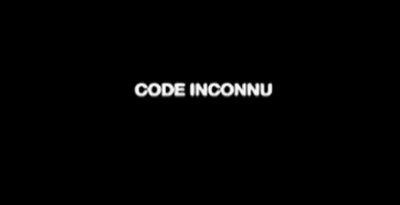Code Unknown: Incomplete Tales of Several Journeys

In a perfect introduction to the film, children play a mime game where a girl acts out gestures but her classmates are not able to decipher it properly. There is an unknown code to communication, as there is an unknown code to identity, past, history, races and societies, the code to interdependence and code to fear and conflict. All these codes are not only unknown but also elusive, the more we try to figure them out, the more we know about their complexity. Haneke captures this idea in this brilliant and essential film.
Code Unknown is a series of fragments from the lives of its main characters. But unlike movies where these characters meet at the end, different stories join themselves in one crucial plot point; Code Unknown establishes that connection in the very first fragment. It might be because the film is not telling us about coincidences and the lives of different people crossing each other but other more important points. The first shot where we meet four different characters is quite brilliant in that way, it's very unsensational, it's very everyday and that's where Haneke makes the point that these interactions are so common to be ignored and the societies have become so complex in terms of identities and connections that any full communication will not only be insufficient but misleading to understand it and like any half truth, it will do more harm than good. That is why Haneke shows just fragment of interactions and communication, like the way we deal them in our lives, without knowing what happening to the person in between the interactions and what is the history behind any gesture and any act.
Anne (Juliette Binoche), who is an actress, lives in Paris with her war-photographer boyfriend Georges (Thierry Neuvic), who is in Kosovo. Georges teenage brother, Jean (Alexandre Hamidi) who lives with her father in countryside works in a barn but Jean wants to get out of it. In the first establishing shot, Jean, who has run away from his father's house meets Anne on a Paris street asks for the new entry code to her apartment, while walking he throws a crumpled bag in the lap of Maria(Luminita Gheorghiu), a Romanian illegal immigrant who is begging on the street. Amadou (Ona Lu Yenke), a teacher of deaf children, pulls an argument with Jean for his behavior and in a turn of unfair events police arrests Amadou and Maria. This first shot builds the connection of the incomplete fragments (as the name suggests, Code Unknown: Incomplete Tales of Several Journeys) that we are about to see.
To talk about those disconnected yet surprisingly narrative sequences are beyond my scope, but we can talk about some of them and more importantly why such fragments are necessary to build a big canvass of interdependent realities and their simultaneous outcomes. All the fragment end with no sense of closure, its like actors still acting and camera still rolling, there is a few second black out between the sequences, which might be thought as the elapse of some time or a detachment technique, to show that its all staged (in fact one of the fragment gives us just a fourth wall view of a stage performance, a woman laughing hysterically), or a thematic tool to show that all these communications are incomplete, unless we look them all in one picture. It too puts onus on its viewer to weave the fragments as they like, and we know that when it comes to trusting the viewers, Haneke is very bighearted. His movies are direct opposite to Hollywood spoon-feeds and audience-pleasers. In some of the episodes/fragments, we see Anne on her acting assignments, which are Haneke's tool to show how thrill can be easily faked, and how popular culture defines our emotional conscience.
There are several sequences which are particularly intense and economic in the way they say things to the viewers, one is where Anne hears the cry of a child and worries about the child but not able to do anything and that particularly sad scene where Maria feels ashamed of herself. There is an extraordinary long shot in train where an Arab kid insults Anne, where Juliette Binoche gives a powerful performance.

Amidst of the chaos and gloom, Haneke puts the fragments of children from all races playing some African beat on drums, a surprisingly hopeful montage of cultures coming together, co-existence and compassion. In the penultimate sequence we see Amadou and his white girlfriend playing drums with the children and that sound spills over to the last dialogue-less sequence. The last scene of the film again shows a child making gestures (more difficult to guess than those shown in the beginning of the film) probably to say to the viewer, see, now that you have seen these fragments, incomplete as they are, can there be any easy answers, can identities be labeled that easily, can a society be graded, classified and categorized that plainly, how a single experience can not justify an act of the society, how much we are interconnected, and how much we deny that fact. In all its chilly long shots, meandering through several incomplete interconnected stories, Code Unknown, at times seems to touch that evasive slice of truth, a code to existence and co-existence.
